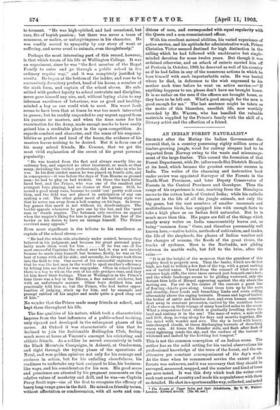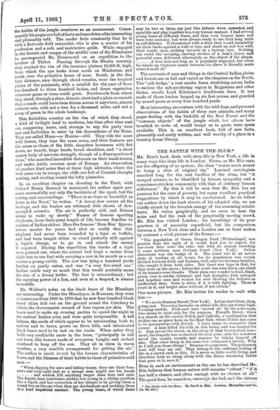AN INDIAN FOREST NATURALIST.* SHORTLY after the Mutiny the Indian
Government dis. covered that, in a country possessing eighty million acres of timber-growing jungle, wood for railway sleepers had to be imported from Norway owing to the waste and mismanage- ment of the large timber. This caused the formation of that Forest Department, with Dr. (afterwards Sir) Dietrich Brand is at its head, which became the greatest economic success in India. The writer of the charming and instructive book under review was appointed Surveyor of the Forests in the North-West Provinces, and later Deputy Conservator of Forests in the Central Provinces and Gorakpur. Thus the range of his experience is vast, reaching from the Himalayan snows to the cotton lands of Central India; while his catholic interest in the life of all the jungle animals, not only the big game, but the vast numbers of smaller mammals and multitudinous birds, has equipped him with enough facts to take a high place as an Indian field naturalist. But he is much more than this. His pages are full of the things which nearly every writer on India unaccountably leaves out, as being "common form" there, and therefore presumably well known here,—native habits, methods of cultivation, and trades, the life of the shepherds, the phases of Indian weather and the changes of seasons, the floods of the great rivers, the tracks of cyclones. Here is the Nerbudda, not gliding between its marble walls, but full to the brim, after the rains :—
" It is at the height of the monsoon that the grandeur of this mighty flood is properly seen. Then the banks, which are 60 feet high, are full to within a few feet of the top, with a great rushing sea of turbid water. Viewed from the summit of what were in summer high cliffs, the river races onward just beneath one's feet ; and the whole landscape seems to be gliding westward, only the distant blue hills of Bhopal appearing against the sky above the moving sea. Par out in the centre of the current a great line of floating objects goes along. Great trees torn up by the roots sail steadily, their heads and branching limbs and roots rolling alternately above the raging torrents. Houses and logs of timber, the bodies of cattle and Sambur deer, and even human remains, float away in constant procession, carried by the resistless force of the waters on their voyage of many hundred miles to the ocean. What a stupendous force, which is gradually levelling down the land and sinking it in the sea! The mass of water, a mile wide and 50 ft. deep, moving along for days and months together, fills the mind with wonder and awe. The sky is lurid with heavy, rain-charged clouds, at times discharging torrents of drenching warm rain. At times the thunder rolls, and flash after flash of vivid lightning rends the sky, and the surface of the torrent is whitened and lashed by the howling hot tempest."
This is not the common conception of an Indian scene. The author has as the solid setting for his varied observations his professional knowledge of the trees of the forest, and the un- obtrusive yet constant accompaniment of the day's work. At the time when he commenced service the extent of the forests was unknown, and it was necessary that they should be surveyed, measured, mapped, and the number and kind of trees per acre noted. It was this duty which took the writer over such vast areas of country and made his acquaintance with them so detailed. He shot in. a sportsmanlike way, collected, andnoted
• The Forests of Upper India and their inhabitants, By T. W. Webber. London : Edward Arnold. D2s. 6d, net.1
the habits of the jungle creatures as an amusement. Conse- quently his pages are full of facts and anecdotes alike interesting
and pleasantly told. The reader feels constantly that he is with a first-rate field naturalist, who is also a master of his profession and a safe and instructive guide. While engaged
in the forests and ranges of the middle zone of the Himalayas be accompanied Mr. Drummond on an expedition to the borders of Thibet. Passing through the Bhotia country, they reached the rim of the immense plateau 18,000 ft. high, from which the eye looks down south on Hindostan, and north over the primitive home of man. South, in the dim blue distance, seen through cloud-wreaths, were the tropical
plains of the peninsula, with a rainfall for the year of from two hundred to three hundred inches, and dense vegetation wherever grass or trees could grow. Northwards from where they stood, through a clear, thin air, stretched a plain so smooth that a coach could have been driven across it anywhere, almost without rain, with not a tree for a thousand miles, and not a scrap of green in the whole landscape.
This forbidden country on the rim of which they stood, a kind of twilight land to moderns, has time after time sent out conquering hosts, and, strange to say, the party were met and forbidden to enter by the descendants of the Huns. They are called Huns—or Hunias—still. They ride the same wild horses, they bear the same arms, and their features are the same as those of the little shapeless horsemen with flat noses, no beards, large heads, broad shoulders, and "a short square body of nervous strength, though of a disproportioned form," who marched incredible distances on their small horses, and under Attila overran most of Europe. An observation of another kind notes that at these high altitudes, where the wild asses run in troops, the cliffs are full of Cornish choughs nesting, and circling round the lofty pinnacles.
In an excellent chapter on shooting in the Terai, with Colonel Henry Ramsey in command, the author again pre- sents successfully not only the incidents of the sport, but the setting and surroundings. "There is no time so beautiful as dawn in the Terai," he writes. "A heavy dew covers all the herbage, and the bushes are whitened with sheets of dew.
spangled cobwebs. The air is perfectly still, and Nature seems to wake up slowly." Names of famous sporting elephants, from their great length of life, become familiar to readers of Indian shikar. Here the famous Ram Bux ' figures, whose master for years had shot so coolly that this elephant had never been wounded by a tiger or buffalo, and had been taught either to stand perfectly still against a tiger's charge, or to go in and attack the enemy if required. During the expedition the tracks of a tiger were pointed out, where the animal bad leapt a ravine from eight feet to ten feet wide carrying a cow in its mouth as a cat carries a young rabbit. The cow was lying a hundred yards further on partly eaten, and was "a very fair-sized one."
Indian cattle vary so much that this would probably mean the size of a Jersey heifer. The feat is extraordinary ; but
the carrying power of a lion, and even of a leopard, is almost incredible.
Mr. Webber's notes on the black bears of the Himalaya are interesting. Under the Himalayas, in Kumaon, they were io numerous from 1860 to 1870 that he saw four hundred black bears' skins laid out on the ground round the Cutchery to obtain the Government reward of four rupees per skin. The
bears used to make up evening parties to spend the night in the natives' Indian corn, and were quite irrepressible. A tall balsam, the seeds of which appear to be intoxicating both to natives and to bears, grows on these hills, and intoxicated black bears used to be met on the roads. When sober they
built very creditable nests in the trees, "principally in tall oak trees, like bowers made of evergreen boughs, and arched overhead to keep off the sun. They sit in them in warm weather, a very sensible arrangement for getting the air." The author is much struck by the human characteristics of bears, and the likeness of their habits to those of primitive wild men :—
"When digging for ants and taking honey, they use their fore- paws and long nails just as a savage man might use his hands .... and seldom kill anything larger than bees and ants. The female bear sometimes suckles her young in a sitting position like a biped, and her correction of her infants is by giving them a sound box on the ear when they are disobedient, and scolding them in a loud impatient manner. The young bears, of which there may be two or three, cry just like infants when corrected, and squabble and play together in a very human manner. I had several young bears at different times, and they soon became tame and were very amusing, but were always ready to use their long nails in self-defence. If threatened with a stick they would invariably set their backs against a wall or tree, and stand up and box with their hands open, striking inwards at a furious rate. Nothing can resist the scooping, clawing strokes of a bear's heavy and powerful arms, delivered alternately on the object of his attack.
A bear does not hug, as is popularly supposed, but when he stands up whatever comes between his claws is literally made minced-meat of."
The accounts of men and things in the Central Indian plains and forests are as full and varied as the chapters on the North. The "salt hedge," a vast zareba fence stretching across India to enclose the salt-producing region in Rajputana and other States, recalls Lord Kitchener's blockhouse lines. It was made of thorn bushes heaped up six feet across, and guarded by armed posts at every four hundred yards.
Most interesting encounters with the wild dogs, and personal observations of the habits of these rare animals, and many
pages dealing with the bird-life of the Bori Forest and the "common objects" of the jungle which few others have
troubled to write of, would tempt us to quote were space available. This is an excellent book, full of new facts, pleasantly and easily written, and well worthy of a place in a country house library.







































 Previous page
Previous page